How to Check Your Cell Phone Signal Strength (Accurately)
Bars Do Not Reflect Signal Strength
When calls start dropping or your data slows to a crawl, it’s natural to glance at your phone’s signal bars for an answer. But here’s the truth: those bars are not a reliable indicator of your actual cell signal strength. This is because the number of bars you see can vary between phone models, carriers, and even operating systems. Thankfully, far more accurate ways to test your signal strength exist.
Take advantage of our system design and installation services. Learn more or call us for a free consultation: 1-800-969-8189.
How to Test Cell Signal Strength on Your Phone
Cell phone signal strength is measured in dBm (decibel-milliwatts). You may find many articles claiming signal strength is measured in dB (decibels), but that’s not entirely accurate. While dB and dBm are related, it's important to understand that:
- dB is a relative measurement indicating change (gain or loss) in signal strength without specifying an exact signal strength value.
- dBm is an absolute measurement, representing power level relative to 1 milliwatt, providing an exact signal strength measurement.
By finding your dBm reading, you can identify your true 5G and 4G LTE signal strength in your specific location. It will not fluctuate based on device manufacture or model.
There are two main ways to measure signal strength:
- Field Test Mode — A built-in diagnostic tool on most smartphones.
- Signal Strength Checker Apps — Downloadable tools that display your real-time signal strength and related network data.
The process and app options differ slightly between Android and iPhone devices. Let’s break it down.
How to Check Signal Strength on Android
Measuring cell signal strength on Android devices is very simple and can be done with just a few taps.
Field Test Mode for Android
The exact path varies by phone model and OS version, but generally, here’s how to do it:
- Turn off your WiFi connection.
- Go to Settings.
- Tap About Phone.
- Tap Status Information or Network
- Tap SIM Card Status.
- Look for Signal Strength — your dBm reading will be listed there.
 |
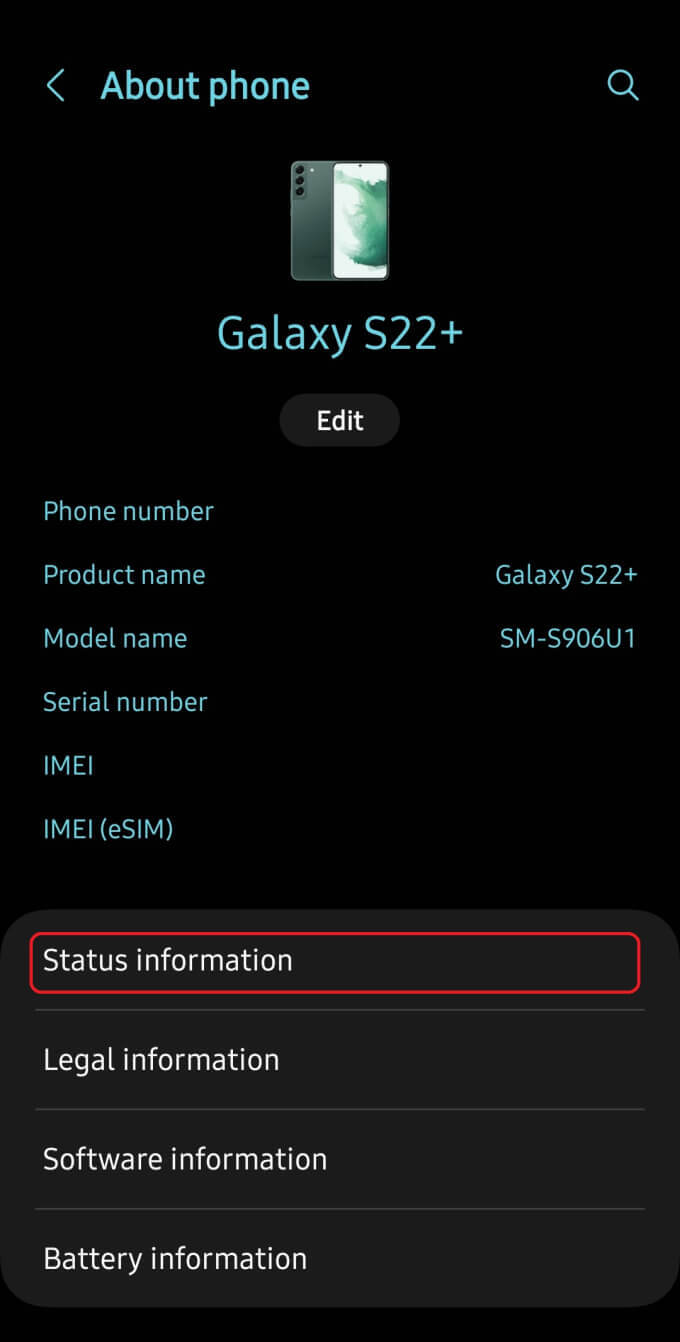 |
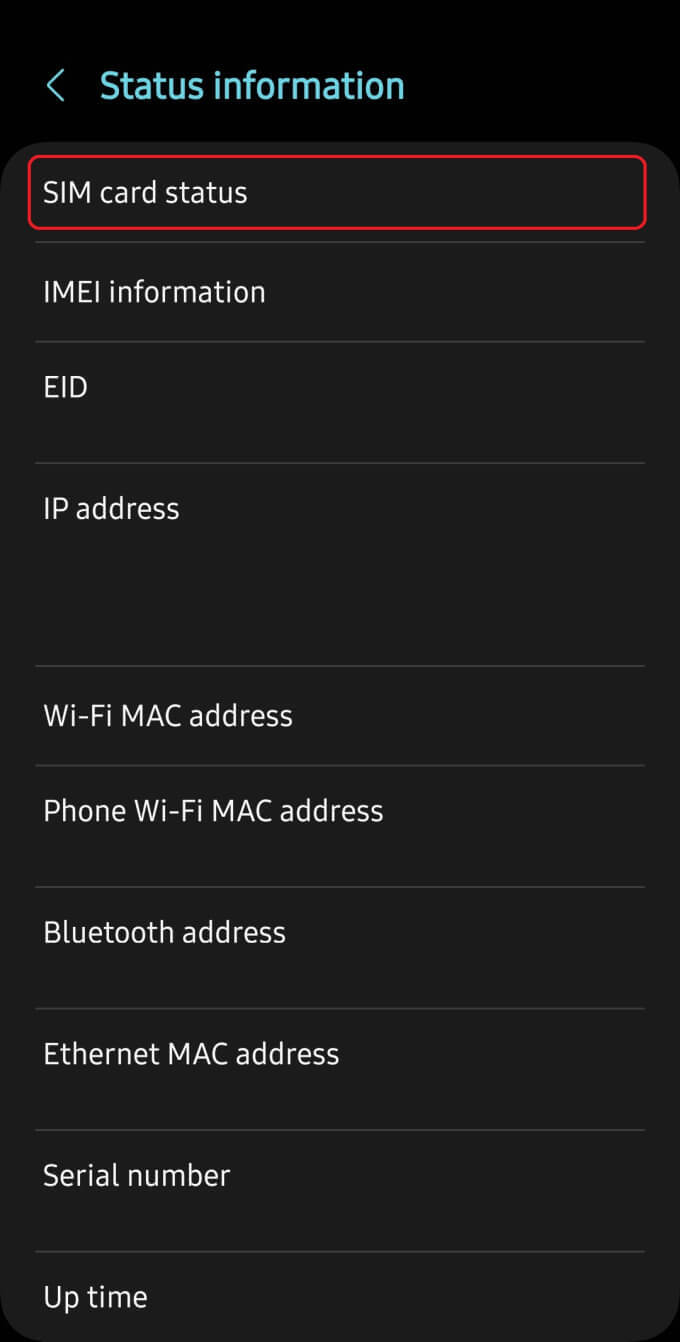 |
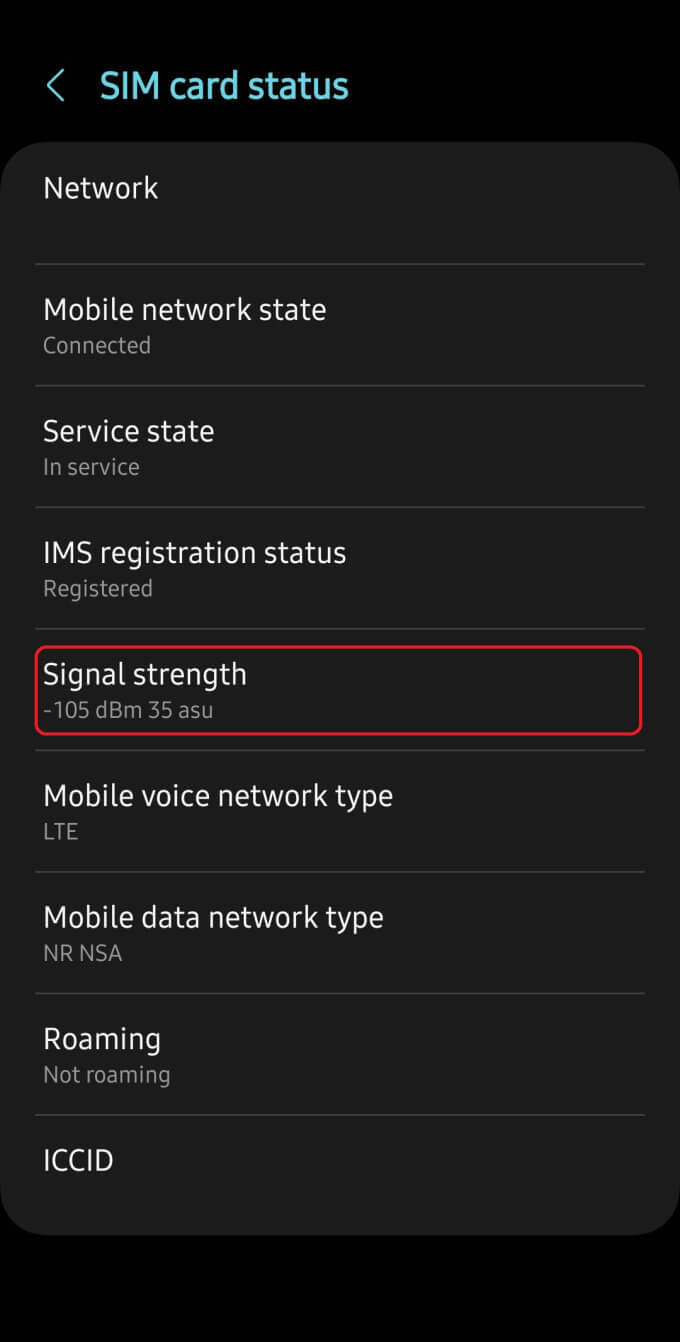 |
Recommended Android Signal Strength Apps
Alternatively, you can use a signal strength app to measure the strength of your phone’s service signal. The Play Store offers a ton of options. These are our top two favorites:
- Network Cell Info Lite: Features an easy-to-read signal measurement gauge that quickly updates as you move location. It also displays network details, such as connected band, RSRQ, RSSNR, and more.
- weBoost App: Simplest signal testing tool available, designed by a leading cell phone signal booster manufacturer. Measuring signal performance is as easy as taping a button. Results are displayed on a color-coded gauge.
How to Check Signal Strength on iPhone
On iPhones, measuring cell signal strength is a little trickier and only possible via Field Test Mode. However, it’s important to note that while every iPhone can access Field Test Mode, not evey model and iOS version will display dBm values due to chipset and carrier limitations.
Field Test Mode for iPhone
Finding your dBm through Field Test Mode on iPhones varies across iOS versions, and it doesn't help that Apple constantly changes the layout of its Field Test Mode screen. In general:
- Turn off your WiFi connection.
- Open your Phone app.
- Dial *3001#12345#* and hit call.
- Field Test Mode will open.
- Look for RSRP (Reference Signal Received Power) values — this is your signal strength in dBm.
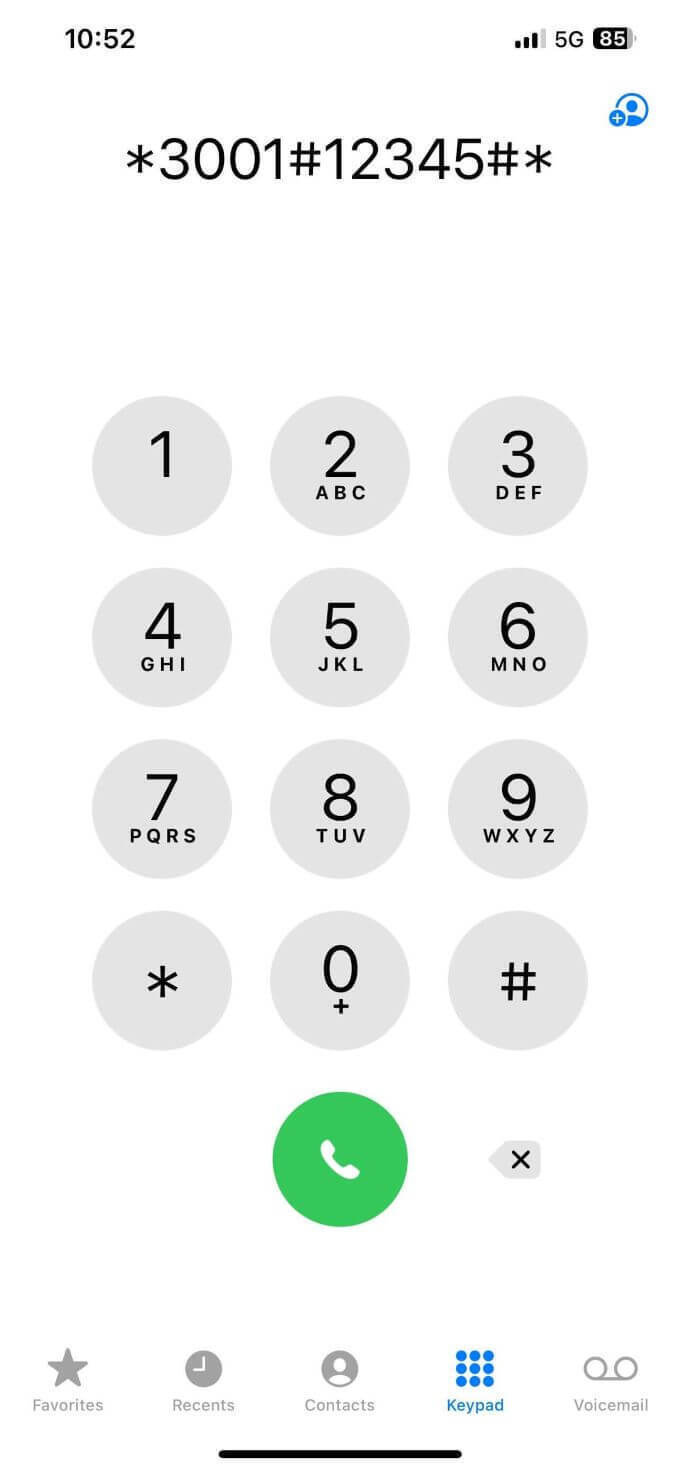 |
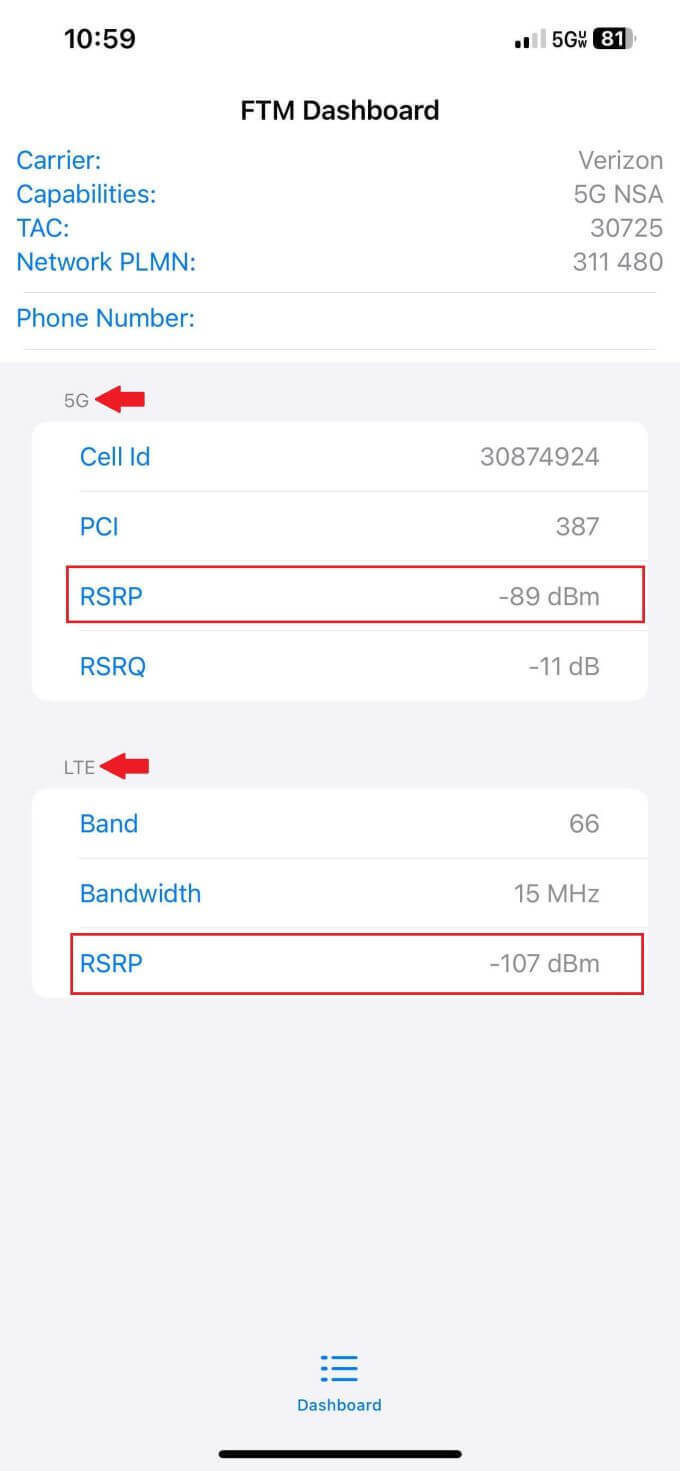 |
For iPhone Field Test Mode instructions by iOS version, see our Field Test Mode guide.
Note: If your iPhone doesn’t show dBm readings, your next-best option is a speed test app to help you find strong signal areas.
Useful iPhone Signal Strength Apps
Unfortunately, the Apple App Store does not offer true signal strength measurement apps. However, here are our top app recommendations that can help make checking your signal strength easier:
- weBoost App: Provides iPhone users with step-by-step Field Test Mode instructions and helps visualize signal reliability.
- Open Signal: While it doesn’t show dBm values, it offers detailed speed tests to identify your best signal spots.
What Is a Good dBm for Cell Phones?
Cell signal strength typically ranges from -50 dBm to -120 dBm. Generally, a good RSRP or dBm reading is anything above -95 dBm. You'll notice dropped calls, failed texts, and slow data the closer you get to -120 dBm.
Here is an estimated dBm signal strength breakdown (and their possible bar assignations, depending on carrier/phone manufacturer):
| Signal Strength (dBm) | General Quality | Typical Bars | Experience |
| -50 to -79 dBm | Excellent | 4-5 Bars | Fast data, uninterrupted calls |
| -80 to -89 dBm | Good | 3-4 Bars | Stable connection |
| -90 to -99 dBm | Fair | 2-3 Bars | Occasional slowdowns |
| -100 to -109 dBm | Poor | 1-2 Bars | Dropped calls, slow data |
| -110 to -120 dBm | Very Poor | 0-1 Bar | Unusable connection |
How to Increase Mobile Signal Strength
If you’re experiencing poor signal strength, then it’s likely the result of cell tower distance, signal-blocking building materials, or physical obstructions. For a complete list, visit our guide on why your service is bad.
Thankfully, cell phone signal boosters are perfect for improving your connection and coverage. These devices capture your existing outside signal, amplify it, and rebroadcast it indoors. For more information, check out our article on How Cell Phone Boosters Work. Once installed, your dBm signal strength will increase, improving voice quality, reducing dropped calls, enhancing data speeds, and extending battery life. Below are real-world results from a cell phone booster installation.
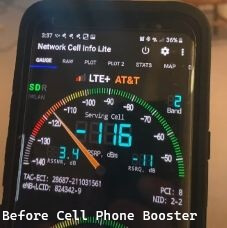 |
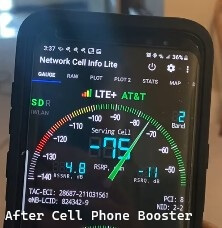 |
*Major dBm improvement post weBoost Installed Home Complete installation in a Rural East Texas home.
Our Top Signal Booster Picks
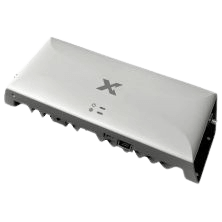
Our most powerful single-carrier booster for homes and offices. Offers 100dB of gain across 4G, 5G, and LTE signals for up to 20,000 sq. ft
Shop Now: Starting at $1,298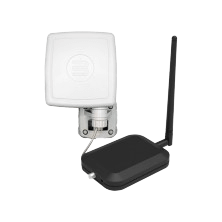
Perfect for renters and small apartments. An easy, renter-friendly installation with everything you need to improve weak indoor signals.
Shop Now: $349.99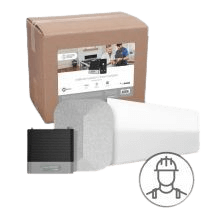
Professional installation included. Great for whole-home coverage up to 7,500 sq. ft.
Shop Now: $1,499.99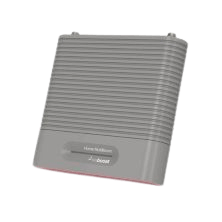
Stylish, tool-free booster ideal for homes up to 5,000 sq. ft.
Shop Now: $569.99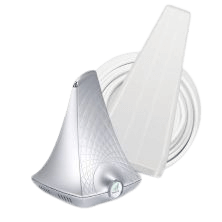
Budget-friendly option for small homes or spot coverage for multiple carriers.
Shop Now: $379.99Contact Us to Boost Your Signal Strength
We specialize in consumer-friendly cellular booster kits as well as customized DAS solutions and WiFi for commercial applications. If you need help finding the right system for your specific needs, give us a call at 1-800-470-6777 or email us at sales@signalboosters.com.
FAQs
Once you’ve figured out how to measure your signal strength, here’s how to put that information to work:
- Walk around your home or property with your phone’s Field Test Mode or app open.
- Identify areas with the highest (closest to -50 dBm) and lowest signal readings.
- Note where your signal strength drops — these are your dead zones.
- You can use this info to choose the best spot for calls and data use, pinpoint the ideal placement for a cell signal booster’s outdoor antenna, and determine if a booster system could help improve your weak areas.
Signal strength is how much signal your phone or other device is receiving. Signal quality is how much noise or interference that signal is contending with.
Radio signals are all around us from other cell towers, other calls, other devices, or even appliances. These signals can interfere with your cell phone connection to the tower. The more interference or noise there is, the lower your signal quality will be.
It is possible to have bad signal quality, and good signal strength or bad strength and good quality. Ideally, the two need to be good for clear calls and data. If you have good signal strength, but terrible quality, you will still experience dropped calls, slow data speeds, and breaks in voice.
RSRP stands for reference signal received power and is displayed in decibel milliwatts. It is the exact amount of signal being received by the device and is used to measure 4G/LTE and 5G. It takes an average of the power of the cell signals that your phone is getting from the tower and shows how strong those signals are. It will be shown on your phone as a dBm reading, between –110 and –50. The closer to –50 you are, the better your signal strength is.
Cellular routers for home or office internet, like the Peplink BR1 Mini and BR1 Pro 5G, also use RSRP measurements for signal strength. This can be found in the router’s interface, either in its app or in your browser. Check your router’s manual to find out how to access the interface.
RSSI or Received Signal Strength Indicator shows how strong a radio signal is. Your phone has an RSSI which shows up as the bars counter. RSSI is a baseline of how strong the signal is after cable and antenna loss. The stronger the RSSI, the stronger your signal is. RSSI is always shown in the negatives, so the closer it is it 0 the better your received signal is.
Interested in Learning More? Check Out Our Cellular Info Hub / WiFi Info Hub





